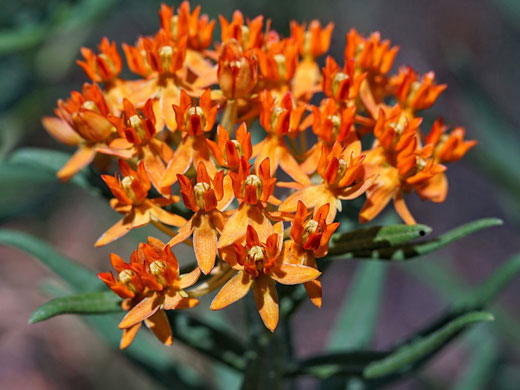Common name:
Butterfly milkweed
Family:
Scientific name:
Asclepias tuberosa
Main flower color:
Range:
The Four Corners states, most of the Great Plains, and states to the east
Height:
Up to 3 feet
Habitat:
Varied; hillsides, streambanks, canyons, lakeshores, grassland, woodland, chaparral, from near sea level to 8,200 feet
Leaves:
Alternate, hairy, variously shaped, up to 5 inches long and 1 inch across
Season:
May to September
Asclepias tuberosa is a widespread and relatively common species, easily-identifiable due to its all-orange flowers and its tapering, cylindrical, upturned seed pods. The plant occurs mostly in the eastern US; in the West it is found in scattered locations in the Four Corners states, including the eastern foothills of the Rocky Mountains in Colorado, the uplands of central Arizona, the Gila National Forest ib New Mexico, and in southeast Utah.
Plants typically produce a cluster of stems, densely hair-covered. Leaves may be lanceolate to ovate or linear, to oblanceolate, generally long and narrow, and sparsely to densely hairy. The inflorescence is a group of umbels, from the upper leaf nodes, each containing between five and 27 heads, on short peduncles, around 1 inch.
The five calyx lobes are narrowly lanceolate in shape, while the corolla lobes are more elliptic, two or three times as long (up to 0.3 inches), colored orange, yellow or reddish. Hoods and horns are similar in color to the corolla.
Plants with wavy, crisped leaf margins are ssp rolfsii, found only in low elevations in Florida and Georgia; all others, with flat leaf margins, are either ssp tuberosa, generally east of the Appalachian Mountains or ssp interior to the west. The latter have flattish leaf bases and pointed leaf tips, the former more rounded leaf tips and bases.
Plants typically produce a cluster of stems, densely hair-covered. Leaves may be lanceolate to ovate or linear, to oblanceolate, generally long and narrow, and sparsely to densely hairy. The inflorescence is a group of umbels, from the upper leaf nodes, each containing between five and 27 heads, on short peduncles, around 1 inch.
The five calyx lobes are narrowly lanceolate in shape, while the corolla lobes are more elliptic, two or three times as long (up to 0.3 inches), colored orange, yellow or reddish. Hoods and horns are similar in color to the corolla.
Plants with wavy, crisped leaf margins are ssp rolfsii, found only in low elevations in Florida and Georgia; all others, with flat leaf margins, are either ssp tuberosa, generally east of the Appalachian Mountains or ssp interior to the west. The latter have flattish leaf bases and pointed leaf tips, the former more rounded leaf tips and bases.
All Contents © Copyright The American Southwest | Comments and Questions | Contribute | Site Map

